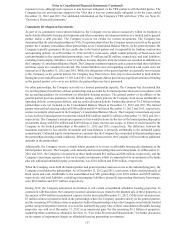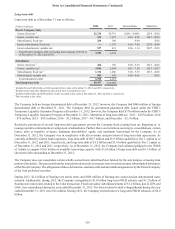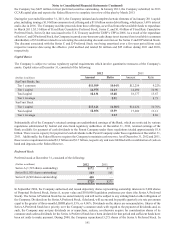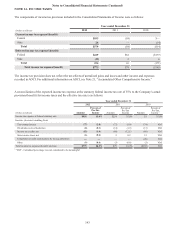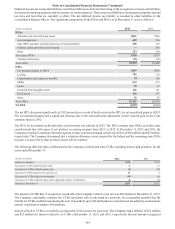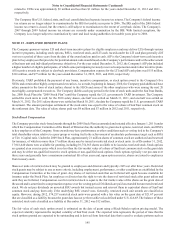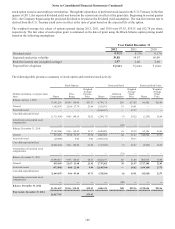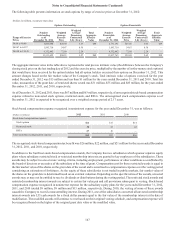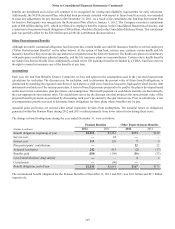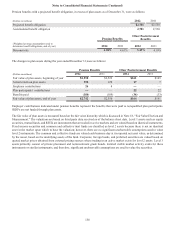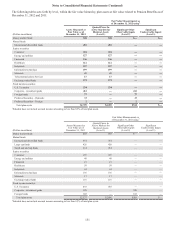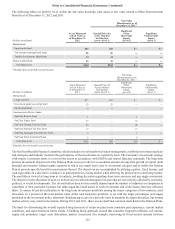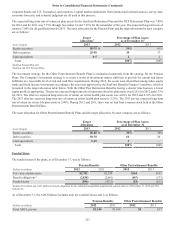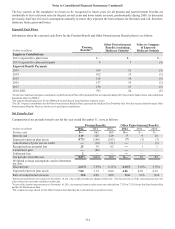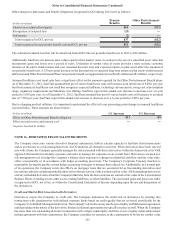SunTrust 2012 Annual Report Download - page 161
Download and view the complete annual report
Please find page 161 of the 2012 SunTrust annual report below. You can navigate through the pages in the report by either clicking on the pages listed below, or by using the keyword search tool below to find specific information within the annual report.Notes to Consolidated Financial Statements (Continued)
145
related to UTBs was approximately $3 million and less than $1 million for the years ended December 31, 2012 and 2011,
respectively.
The Company files U.S. federal, state, and local consolidated and separate income tax returns. The Company's federal income
tax returns are no longer subject to examination by the IRS for taxable years prior to 2006. The IRS audit of the 2006 federal
income tax return is closed, but the return is still subject to examination to the extent of carryback claims. The Company's
2007 through 2009 federal income tax returns are currently under examination by the IRS. With limited exceptions, the
Company is no longer subject to examination by state and local taxing authorities for taxable years prior to 2006.
NOTE 15 - EMPLOYEE BENEFIT PLANS
The Company sponsors various LTI and short-term incentive plans for eligible employees and may deliver LTIs through various
incentive programs, including stock options, RSUs, restricted stock, and LTI cash. Awards under the LTI cash plan generally cliff
vest over a period of three years from the date of the award and are paid in cash. AIP is the Company's short-term cash incentive
plan for key employees that provides for potential annual cash awards based on the Company's performance and/or the achievement
of business unit and individual performance objectives. For the year ended December 31, 2012, the Company's AIP plan included
a higher number of eligible participants, of which some participants previously received compensation under other incentive plans.
All incentive awards are subject to clawback provisions. Compensation expense for the LTI and AIP cash plans was $155 million,
$116 million, and $77 million for the years ended December 31, 2012, 2011, and 2010, respectively.
Previously, TARP prohibited the payment of any bonus, incentive compensation, or stock option award to the Company's five
NEOs and certain other highly-compensated executives. As a result, beginning in January 2010, the Company paid additional base
salary amounts in the form of stock (salary shares) to the NEOs and some of the other employees who were among the next 20
most highly-compensated executives. The Company did this each pay period in the form of stock units under the SunTrust Banks,
Inc. 2009 Stock Plan (the "2009 Stock Plan") until the Company repaid the U.S. government's TARP investment. The Company
settled the stock units in cash; for the 2010 salary shares, one half was settled on March 31, 2011, and one half was settled on
March 31, 2012. The 2011 salary shares were settled on March 30, 2011, the date the Company repaid the U.S. government's TARP
investment. The amount paid upon settlement of the stock units was equal to the value of a share of SunTrust common stock on
the settlement date. The value of salary shares paid was $4 million and $7 million in 2012 and 2011, respectively.
Stock-Based Compensation
The Company provides stock-based awards through the 2009 Stock Plan (as amended and restated effective January 1, 2011) under
which the Compensation Committee of the Board of Directors has the authority to grant stock options, restricted stock, and RSUs
to key employees of the Company. Some awards may have performance or other conditions such as vesting tied to the Company's
total shareholder return relative to a peer group or vesting tied to the achievement of an absolute performance target such as ROA
or Tier 1 Capital ratio. Under the 2009 Stock Plan, approximately 21 million shares of common stock are authorized and reserved
for issuance, of which no more than 17 million shares may be issued as restricted stock or stock units. As of December 31, 2012,
17,941,440 shares were available for granting, including 10,754,365 shares available to be issued as restricted stock. Stock options
are granted at an exercise price which is no less than the fair market value of a share of SunTrust common stock on the grant date
and may be either tax-qualified incentive stock options or non-qualified stock options. Stock options typically vest pro-rata over
three years and generally have a maximum contractual life of ten years and, upon option exercise, shares are issued to employees
from treasury stock.
Shares or units of restricted stock may be granted to employees and directors and typically cliff vest after three years. Restricted
stock grants may be subject to one or more criteria, including employment, performance, or other conditions as established by the
Compensation Committee at the time of grant. Any shares of restricted stock that are forfeited will again become available for
issuance under the Stock Plan. An employee or director has the right to vote the shares of restricted stock after grant unless and
until they are forfeited. Compensation cost for restricted stock is equal to the fair market value of the shares on the grant date of
the award and is amortized to compensation expense over the vesting period. Dividends are paid on awarded but unvested restricted
stock. We do not pay dividends on unvested RSU awards but instead accrue and reinvest them in equivalent shares of SunTrust
common stock and pay them only if the underlying RSU award vests. Generally, restricted stock unit awards are classified as
equity. However, during 2012, 574,257 restricted stock units were granted with a fair value on the grant date of $21.67 per unit
that are classified as a liability because the grant date has not yet been achieved as defined under U.S. GAAP. The balance of those
restricted stock units classified as a liability at December 31, 2012 was $12 million.
The fair value of each stock option award is estimated on the date of grant using a Black-Scholes option pricing model. The
expected volatility represents the implied volatility of SunTrust stock. The expected term represents the period of time that the
stock options granted are expected to be outstanding and is derived from historical data that is used to evaluate patterns such as




